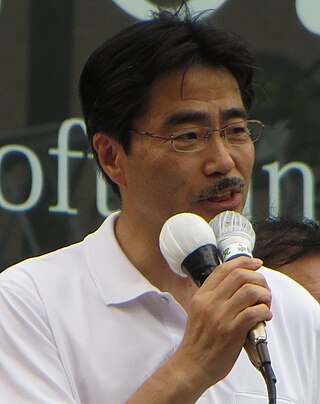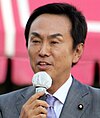
Akihiro Ota is a Japanese politician of the Komeito Party and a former member of the House of Representatives in the National Diet. Ota represented three districts within the Tokyo metropolis since he first entered the Diet in 1993. He served as chief representative of the Komeito Party from 2006 until the general election in September 2009, at which time he lost his seat in the Diet. Upon his return to the House in December 2012, Ota was appointed as the Minister of Land, Infrastructure, Transport and Tourism, a post he held until October 2015.

General elections were held in Japan on August 30, 2009 to elect the 480 members of the House of Representatives. The opposition Democratic Party of Japan (DPJ) defeated the ruling coalition in a landslide, winning 221 of the 300 constituency seats and receiving 42.4% of the proportional block votes for another 87 seats, a total of 308 seats to only 119 for the LDP.

The Tokyo 3rd district is a constituency of the House of Representatives in the Diet of Japan. It is located in Tokyo and encompasses Shinagawa ward and several outlying islands that belong to the Tokyo Metropolis.
The 17th unified local elections in Japan took place in April 2011. In the first phase on April 10, 2011, 12 governors, 41 prefectural assemblies as well as five mayors and 15 assemblies in cities designated by government ordinance were elected. In the second phase on April 24, 2011, mayors and assemblies in hundreds of cities, "special wards" of Tokyo, towns, and villages were up for election. Additionally, a by-election for the National Diet was held in Aichi on April 24.

The Shikoku proportional representation block is one of eleven proportional representation (PR) "blocks", multi-member constituencies for the House of Representatives in the Diet of Japan. It consists of Shikoku region covering Tokushima, Kagawa, Ehime and Kōchi Prefectures. Following the introduction of proportional voting it elected seven representatives in the 1996 general election. When the total number of PR seats was reduced from 200 to 180, the Shikoku PR block shrank to six seats.

The Tōkyō proportional representation block, or more formally the proportional representation tier "Tokyo Metropolis electoral district", is one of eleven proportional representation (PR) "blocks", multi-member constituencies for the House of Representatives in the Diet of Japan. It consists solely of the prefecture of Tokyo making it one of two blocks covering only one prefecture, the other being Hokkaido. Following the introduction of proportional voting Tokyo elected 19 representatives by PR in the 1996 general election, and 17 since the election of 2000 when the total number of PR seats was reduced from 200 to 180.
Events in the year 2012 in Japan.

Prefectural elections for the Tokyo Metropolitan Assembly was held on 23 June 2013, one month before 2013 Japanese House of Councillors election.

The 2014 Tokyo gubernatorial election took place on February 9, 2014 to replace outgoing Governor Naoki Inose, who resigned effective December 24, 2013. Yōichi Masuzoe was declared the winner in exit polling, with a substantial lead over the fifteen other candidates. His final tally was 2,112,979 votes (42.86%), with his two closest competitors Morihiro Hosokawa and Kenji Utsunomiya failing to break the 20% mark. Total turnout was 4,930,251 (46.14%), significantly lower than the 62.6% turnout in the 2012 election.
The first stage of the 18th unified local elections in Japan took place on April 12, 2015. The Liberal Democratic Party under leadership of Shinzo Abe was the overall victor, winning many races including all ten gubernatorial races and 1,153 of the 2,284 assembly seats at stake. Further elections for municipal mayors and assemblies took place on April 26.

House of Councillors elections were held in Japan on Sunday 10 July 2016 to elect 121 of the 242 members of the upper house of the National Diet, for a term of six years. As a result of the election, the Liberal Democratic Party–Komeito coalition gained ten seats for a total of 145, the largest coalition achieved since the size of the house was set at 242 seats.
The 2015 Hyōgo prefectural election was an election for the Hyogo Prefectural Assembly held on 12 April 2015 as part of the 2015 unified local elections in Japan. The election saw the number of assembly members reduced from 89 to 87 and the number of electoral districts reduced from 41 to 40. Voting was held in 23 districts and representatives for the remaining 17 districts were elected unopposed. The election was held in the wake of the political expenses scandal that was exposed in July 2014 involving multiple assembly members and was notable for former assemblyman Ryutaro Nonomura's outburst of uncontrolled sobbing at a news conference.

The 2016 Tokyo gubernatorial election took place on 31 July 2016 to elect the successor to Governor Yoichi Masuzoe, who submitted his resignation to the Tokyo Metropolitan Assembly on 15 June 2016. By-elections in four of Tokyo's cities were held on the same day to fill vacancies in the Assembly.
A by-election was held on 31 July 2016 to fill vacancies in four districts of the Tokyo Metropolitan Assembly. The elections were held simultaneously with the gubernatorial election. Nominations for the election were announced on 22 July 2016. Liberal Democratic Party candidates won all four elections.

A by-election for the Tokyo 10th district in the Japanese Japanese House of Representatives was held on 23 October 2016 to replace Yuriko Koike, who vacated the seat to contest the Tokyo gubernatorial election in July 2016. Koike, a member of the Liberal Democratic Party (LDP), had represented the district since the December 2012 general election and also served a previous term from 2005 to 2009. The election was won by LDP candidate Masaru Wakasa, an incumbent member for the Tokyo proportional representation block who had supported Koike during her gubernatorial campaign. A separate by-election for the Fukuoka 6th district was held on the same day.

Prefectural elections for the Tokyo Metropolitan Assembly were held on 2 July 2017. The 127 members were elected in forty-two electoral districts, seven returning single members elected by first-past-the-post, and thirty-five returning multiple members under single non-transferable vote. Four districts had their magnitude adjusted in this election to match population changes.

Prefectural elections for the Tokyo Metropolitan Assembly were held on 4 July 2021. The 127 members were elected in forty-two electoral districts, seven returning single members elected by first-past-the-post, and thirty-five returning multiple members under single non-transferable vote. Two districts had their magnitude adjusted in this election to match population changes.

House of Councillors elections were held in Japan on 10 July 2022 to elect 125 of the 248 members of the upper house of the National Diet, for a term of six years. The elected candidate with the fewest votes in the Kanagawa prefectural district will serve for three years, as the district combined its regular and byelections.
Akimasa Suzuki is a Japanese politician who is the Mayor of Ōta, a Special ward of Tokyo, since April 2023. A former member of the Tokyo Metropolitan Assembly, Suzuki was chairman of the Special Committee on Budget and Chairman of the General Affairs Committee.
















